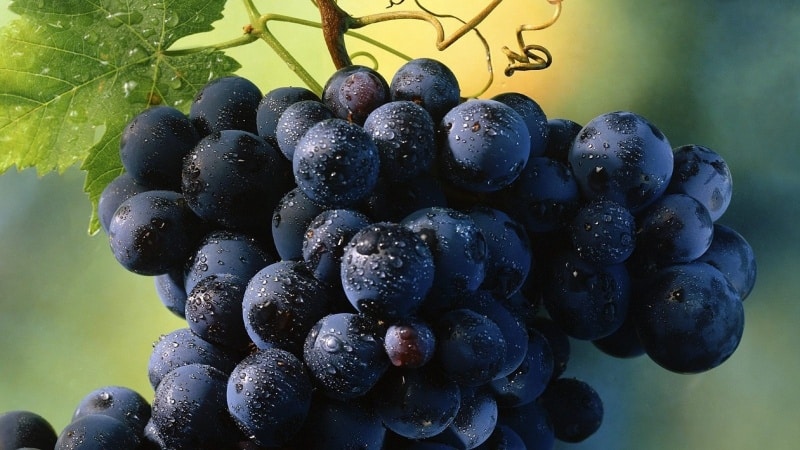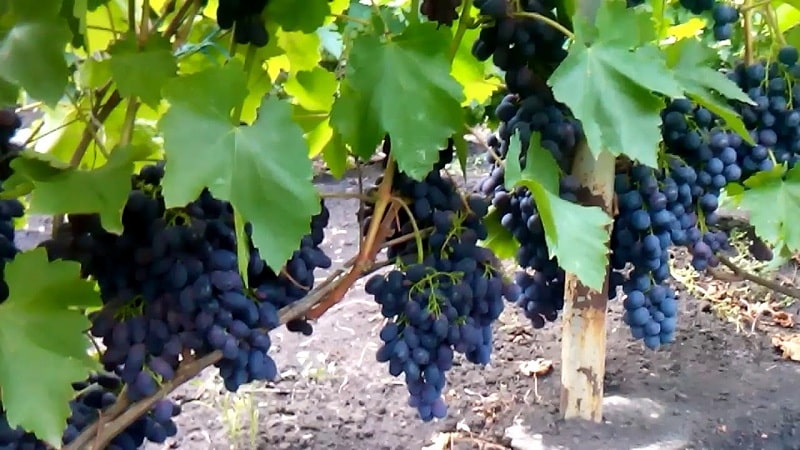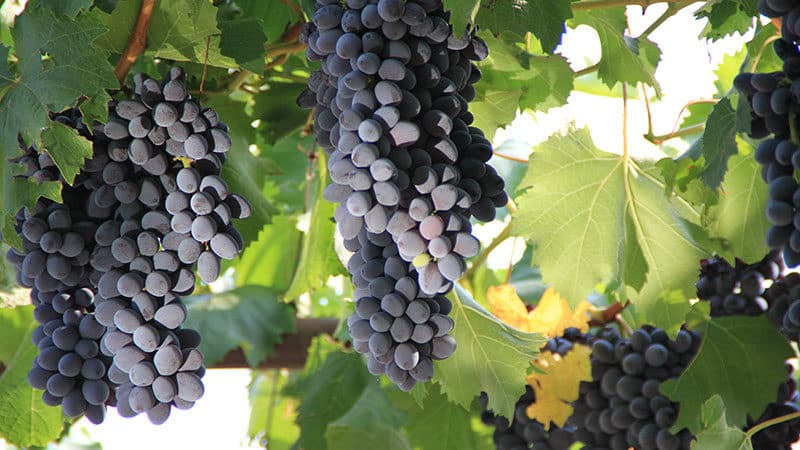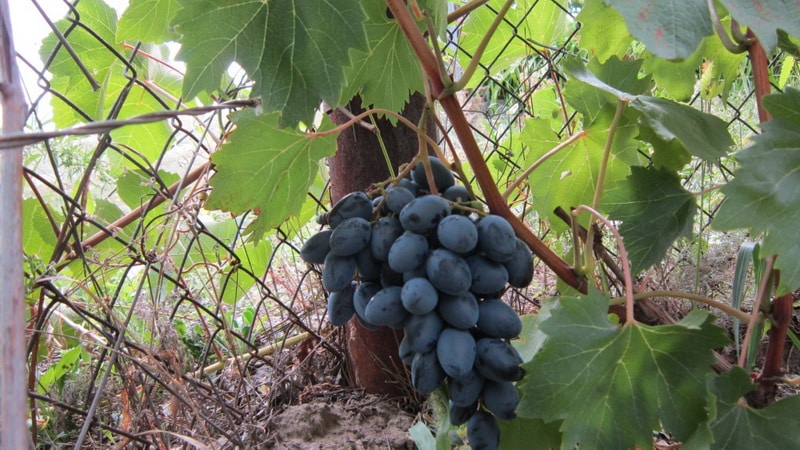Variety of dark grape varieties
Dark grapes are an indispensable ingredient for making wine and juice, champagne and other drinks. It contains amino acids and plant fibers, glucose and fructose. The most delicious and environmentally friendly grapes are those grown on your own plot. Every gardener takes care of bushes and vines, regularly trims dry shoots and fertilizes the crop with mineral complexes for rapid growth. Productivity also depends on the choice of variety: one grape is grown only in the south, while another is frost-resistant and suitable for planting in central Russia.
Dark grape varieties
Varieties vary in fruit size and shape, color and taste. Small berries are processed for harvesting, large ones are consumed fresh or such grapes are grown for sale.
With long fruits

Long black grapes from Baikonur are distinguished by their commercial qualities. The weight of the bunch is about 1.2 kg, the mass of the berry is 16 g, the length is 5 cm. The peel is of medium density, but durable, the color is dark purple, with a reddish tint. There is a dense wax coating on the surface, thanks to which the berries retain their marketability and taste and are suitable for transportation. The pulp is pleasant, sweet in taste, with a rich aroma. The grapes are suitable for fresh consumption and processing; jam, juices, wines, and compotes are prepared from the harvest.
The advantages of the variety include self-pollination, suitability for cultivation in central Russia, and early ripening (the harvest is harvested at the end of July).The bunches ripen gradually, so they feast on juicy berries until September. The height of the plant is 4 m, so a garter to a support is required, otherwise the shoots will break under the weight of large berries.
Very small black grapes

What variety of small black grapes is considered the best? Gardeners celebrate Odessa black. The average weight of a bunch is 140 g, the weight of the berry is about 1 g. The shape of the fruit is round-oval, black in color, with a dense waxy coating. The skin is strong, the flesh is juicy, the taste is grape-cherry, with a pleasant aftertaste.
Odessa black is a wine variety; it is grown both in home gardens and on large farms. The growing season is 160–170 days; the berries ripen in late September or early October, depending on climatic conditions.
Interesting! Dry red and dessert wines are prepared from Odessa black grapes. The drink has an attractive ruby color and a fresh taste.
Advantages of the variety: fruitful shoots, versatility in use, ease of care. Odessa black is resistant to gray rot and oidium, and tolerates frost well. It is planted in the south and central region.
Brown grapes
There are no brown varieties; in nature, only fruits with a brown-golden tan are found. One of the popular varieties is Rkatsiteli grapes. Late-ripening and winter-hardy, it rarely suffers from mildew and gray rot, and is not damaged by insect pests. The bushes are vigorous, the shoots ripen quickly. The weight of a cylindrical bunch is 140–200 g, the density is average. The berries are oval, the weight of one is up to 2 g, the color is greenish, with a brown tan. The skin is thin, the pulp is of medium density, there are 1-2 seeds inside. The taste is pleasant, moderately sweet.Rkatsiteli is used in cooking: dried, processed, made into drinks and preparations for the winter.
To obtain a rich harvest, it is recommended to pay attention to fertilizing: Rkatsiteli reacts favorably to fertilizers with ammonium nitrate and potassium magnesium. For the first time, the procedure is carried out during the flowering period to speed up fruit set.
The darkest grape variety

Grape Codrianca grown in the Ural, North Caucasus, and Lower Volga regions. The ripening period is very early - an average of 115 days pass from bud break to harvest. The bushes are vigorous, the vine ripens completely and does not need pinching. Codryanka bears fruit for 2 years from the moment of planting. The variety is frost-resistant, can withstand temperatures down to -22°C, and is also resistant to spring frosts. Summer residents cover it for the winter and cut off diseased or too long shoots.
The clusters are large, average weight - 600 g. The shape is conical, the berries are located tightly to each other. The fruits are elongated, large, weigh 6–8 g, black in color. The skin is dense, there is a slight waxy coating. The grapes hold tightly to the branch and do not fall off after ripening. The taste is pleasant, the tasting score is 8.2 points out of 10. Another advantage of Kodryanka is that a good harvest is harvested even from rocky and poor soils.
This is interesting:
The best varieties of black grapes

Grapes can be early, mid-ripening and late. The ripening period depends on the characteristics of the variety, weather conditions, and compliance with agrotechnical rules. A suitable plant is selected for each region.
Early
Early ripening varieties ripen in late July - early August.The berries are eaten fresh or used to make drinks and desserts. It is recommended to grow early varieties in regions with an unstable climate.

Athos
The growing season is 95–100 days. The bush bears fruit for 3 years after planting and tolerates frosts down to -23°C. The weight of the bunch varies from 700 to 1500 g, depending on the soil and climate. The berries are medium in size, weighing about 8 g per one. The color is attractive black and blue, the skin is durable. The flesh is burgundy, juicy and sweet.
Ripe berries do not crack within 30 days after ripening, so many gardeners are in no hurry to harvest. Athos is a table variety, so its berries make delicious liqueurs, juices, and compotes. Bushes are not difficult to care for.
Ekaro-35
The table variety has an extremely early ripening period and ripens in 85–100 days. The clusters are oblong, the average weight of one is 400 g. The berries are round in shape, weigh about 4 g, the color is dark blue. The variety is valued for its juicy and aromatic fruit pulp with a pleasant aftertaste. Tall bushes are resistant to mildew and fruit rot, and are slightly affected by insects.
It is recommended to plant Ekaro-35 in a spacious and sunny area, since the variety is demanding in terms of growing conditions. Grapes cannot tolerate excess moisture - the fruits crack and lose their taste.
Fun
The early table variety is universal in use and ripens in 100–110 days. The bushes are vigorous, the leaves are large, dark green. The berries are oblong, oval, the skin is dark blue, with a waxy coating. The weight of the berry is about 10 g, the harvest is distinguished by its commercial and transportable qualities. The pulp is dense and crispy, the taste is sweet, with a slight nutmeg aftertaste.
The flowers are bisexual, so Zabava does not need additional pollinators.The shoots ripen quickly and are frost-resistant down to -20°C. Seedlings are planted in windless areas.
This is interesting:
Review of the best white grape varieties
Mid-season

Mid-ripening grapes are considered the most unpretentious. The berries ripen by the middle or end of August and are distinguished by their large size and dense, sweet pulp.
Kuban
The table variety produces a harvest on August 20–25. The bunches are conical and weigh from 1 to 1.5 kg. The berries are oblong, black, with a slight waxy coating. They weigh about 10 g, the skin is dense. The taste is sweet, with a refreshing pleasant sourness.
The advantages include the attractive appearance of the fruits and bunches, large size, and sweet taste. The berries are suitable for storage and transportation and are not affected by wasps and other insects. The variety is resistant to mildew and can withstand frosts down to -20°C.
Velika
The table variety is grown in central Russia and the southern regions. The bushes are vigorous, the shoots grow quickly. The flowers are bisexual, which guarantees a stable yield. The weight of the bunch is about 600 g, the shape is conical. The weight of the berry is 13 g, the shape is oblong, with a pointed apex, the color is red-violet-black. The skin is dense, but the taste is not noticeable. The flesh is crispy and dense, the taste is sweet, the aroma is medium. Great for transportation and can be stored in the refrigerator for up to 1 month. The berries are used fresh and for processing.
Amursky
A mid-season technical grape variety ripens at the end of August or early September. The bushes are vigorous and strong, the leaves are large. The bunches are loose, cylindrical-conical in shape. The weight of the bunch is about 250 g. The berries are round-oval, weighing 6 g.The color is black-blue, the peel is dense but thin. The taste is sweet and sour dessert.
Reference. To propagate Amur, seeds, cuttings or offshoots are used. For planting, choose a sunny place on the south side of the garden. An excellent option would be a hilly area, protected from winds and drafts. Supports are placed next to the seedling.
Amur is frost-resistant, can withstand temperatures down to -40°C. After transplantation, it takes root in any soil and grows quickly. Due to its high growth, the variety is often used for landscaping garden plots.
Late

Late grape varieties begin ripening in mid-September and end in mid-October. The harvest is used for processing or sale, transported and stored in a basement or cellar.
Dachny
The table variety can withstand temperatures down to -25°C and is resistant to viral and fungal diseases. The clusters are large and weighty - the weight of one reaches 500 g, and the shape is cone-shaped. The berries are black and purple, each weighs about 4 g. The taste is interesting - sweet, with a taste of prunes. The aroma is rich, the pulp has a delicate consistency.
The vines ripen quickly, the plant is unpretentious in care. The harvest is harvested at the end of September; the berries do not fall off after ripening. The fruits are used for making baked goods, marshmallows, cakes, and drinks.
December
The frost-resistant Dekabrsky grape variety can withstand temperatures down to -27°C; it is grown in the middle zone, the Ural and Far Eastern regions. The clusters are medium dense and cylindrical in shape, weighing about 300 g. The berries are ovoid, weighing 4 g, dark purple in color, with a dense waxy coating. The pulp is juicy and fleshy, the taste is harmonious and sweet.
December is resistant to fungal diseases, the vines ripen quickly and smoothly, the fruits do not fall off or crack. The grapes are suitable for storage, fresh consumption and wine making.
Peaceful
Ripens in the second half of September, drought-resistant, frost-resistant. The weight of the bunch is about 1 kg, some specimens reach 2 kg. The density is average, the shape of the berries is oval, the weight is about 10 g. The color is black, the thick peel is covered with a strong waxy coating. The taste is harmonious, refreshing, with a slight sourness. Frost resistance - down to -21°C. After harvesting, the berries retain their taste and color for 25–30 days.
Attention! After harvesting, gardeners inspect the bunches and throw away limp and spoiled berries. For long-term storage, unwashed bunches are placed in a bag and placed in the refrigerator at a temperature of 0°C and a humidity of 90–95%. Grapes are kept away from products with strong odors.
Conclusion
Before planting grapes, it is important to pay attention not only to the name of the variety, but also to a detailed description of the berries, to find out which qualities predominate. Dark varieties are popular not only among winemakers, but also among amateur summer residents. Gardeners plant Kuban, Dachny, Velika, and Zabava grapes. Their fruits are distinguished by attractive color and shape, and sweet pulp. The variety with brown berries, Rkatsiteli, and the blackest grape, Kodryanka, look interesting.
The description is disgusting! No systematics. A set of some non-obvious, so-called “knowledge”! There is no point or need for such nonsense!